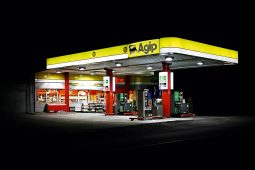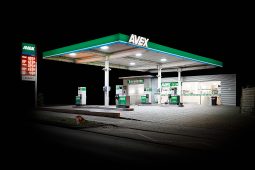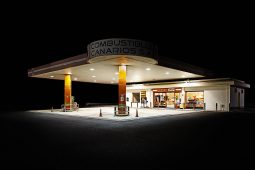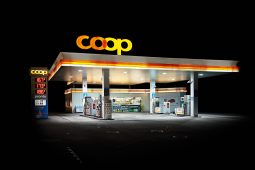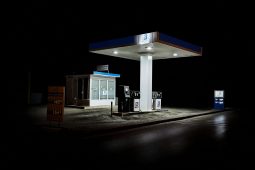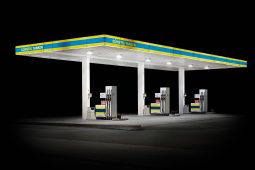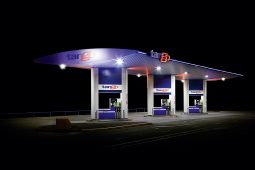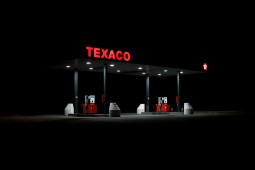Petrol Stations
Die Tankstelle am Rand von urbaner Zivilisation ist Teil eines Alltags der Fortbewegung. An amerikanischen Highways und europäischen Autobahnen ist sie Teil eines materialisierten Glaubes an Fortschritt durch Technik – ein medial-mythisch aufgeladener Ort. In den Arbeiten ihrer Reihe ‘Petrol Stations’ entfernt Vanessa Leißring Tankstellen aus ihrem Gebrauchskontext und isoliert sie in dokumentarisch anmutenden, selbstleuchtenden Fotografien. Sie sind Anlaufstellen als Orte der Versorgung: daher bekommen Tankstellen ihren Zweck als Teil einer Verwertungskette, an dessen Anfang und Ende Mensch und technische Entwicklungen stehen.
Durch die Dekontextualisierung wird die Sicht auf Form, Anordnung und Konstruktion frei. Leißrings Arbeiten sind eine typologische Betrachtung der gleißend hellen Tankstellen. Die Gebäude sind meistens nicht mehr als Überdachungen, getragen von Säulen, ausgeleuchtet vom Neonlicht in den Farben der Betreiberfirmen. Die Tankstellen ragen – ästhetisiert und monolithisch – in einen schwarzen Nachthintergrund. Leißring zeigt die Orte und ihre Architektur als Skulpturen im öffentlichen Raum und thematisiert gleichzeitig mögliche Bezüge zu Branding und urbane Architektur. Sehr gesättigt für unnatürliches Licht, sind die Leuchtreklamen an den Tankstellen Referenz und Orientierung. Aber in den menschenleere Szenarien wirken die Neonlichter wie eine Nachricht ohne Zielgruppe – ein Medium ohne Inhalt. Die Namen der Betreiberfirmen werden zu Ornamenten, die die Dächer und Beschilderung zieren aber nichts kommunizieren. Die Tankstellen sind auf Leißrings Fotographien nächtliche Nicht-Orte ohne Zusammenhang zu Raum oder zu einer Vorstellung von ihrem Nutzen. Die Straßen gehen zwar von rechts nach links durch Bild, enden aber in Schwarz. Bewegung ist nicht erkennbar, Abläufe sind unterbrochen. In untrennbarer Einheit verwandeln Architektur und Licht aus den Gebrauchsgegenständen ästhetisiert Abzüge ihrer selbst.
Das ganze Projekt finden Sie unter:
petrolstations.de
Petrol Stations
The petrol station – on the edge of urban civilization – is an integral part of our daily locomotion. Placed on the side of the American Highway and the European Autobahn, it is the materialized belief in progress through technology. The petrol station is a media-mythical charged location. In the works of her series ‘Petrol Stations’ Vanessa Leißring removes the petrol stations from their context and isolates them in documental self-luminous photographs. They are focal points of supply: that is what furnishes them with their meaning as a part of an utilization mechanism which is initiated by the human being and comes to an end in technical progress.
The decontextualizing reveals a gaze on form, arrangement and construction. Leißring’s typological portraits of the petrol stations show the bare buildings: a simple roofage, pillared, illuminated by neon-lights in the colors of the petrol companies. The stations loom monolithic into the night’s black sky. Her photographs show the locations and their architecture as sculptures in public space and addresses possible relations to branding and urban architecture. The light of the neon-signs – appearing unnaturally saturated – serves as a point of reference and guidance. But the in the deserted scenarios, they become a message without a target group – a medium without contents. The names of the gas companies turn into ornaments, which embellish the roofs and signage but they don’t communicate. On Leißring’s photographs the stations are nightly wasteland without any connection to their usage. The street runs through the image but end in black. There is no visible movement and processes are interrupted. Connected in inseparable unity architecture and light turn the everyday objects into aestheticised impressions of themselves.
Find the whole project here:
petrolstations.de

